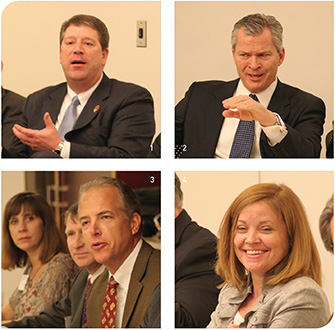
1. Technological skills, said Darin Heyen, don’t mean much if you don’t know how to build a building. | 2. Steve Hancock said a lot of trial and error goes into determining which new technologies actually work. | 3. Phil Thomas pointed out the challenges posed by multiple incompatible platforms for planning and tracking of construction work. | 4. Angie McElhaney said the newest generation entering the sector was keenly interested in philanthropic opportunities.
“Quite a bit. It’s ongoing,” said Steve Hancock. The trick is to get them to embrace the technology while still at the apprentice stage. As he explained, though, there is a lot of “junk” technology in the marketplace, things that seem cool but don’t pan out. There is still a lot of trial and error involved in finding the right tools.
“Getting some of the [experienced] guys to adapt to the ever-changing technology is as much of a challenge as getting the new folks coming in,” said Mike Bowman. He cited the case of one superintendent for whom a smart phone was a huge breakthrough. Six months later, though, he was reading digitized plans off a laptop.
“We’re finding that some of the young individuals coming into the marketplace
are driving some of the seasoned, skilled folks out there in the marketplace to get on board or get left behind,” said Brett Gordon.
Darin Heyen believes that the young kids coming out of college may have the technological background, but they don’t know how to build a building or lay out form work to pour concrete. He is worried that the industry is losing too many of the people with real skills, and he is not sure who is going to replace them.
“That’s true in design as well,” said Laura Lesniewski. “We’re blinded by how cool some of this is,” she added, but she worries there is trouble ahead “if we don’t marry that with experience and people who know how to put a building together.”
Leadership Development
Dawn Taylor, executive director at AIA KC, was pleased to see leadership development on the agenda. About eight years ago, Taylor explained, the AIA launched its Pillars Leadership Program. Its purpose is to train individuals from within AIA membership to help shape both the profession and the larger community.
One of the unique features of the Pillars program is that participants develop their own goals and areas of emphasis. “That’s very intentional on our part,” said Taylor, “because this new generation of leaders in our industry is going to really want to make their own mark and put their own stamp on things.”
The Construction Leadership Council, a subgroup of the AGC, has a program much like the AIA’s. Angie McElhaney, a partner with the accounting firm Marks Nelson Vohland Campbell Radetic, also serves as chair this year of that council. The CLC provides educational programs, networking events, a leadership development course, and philanthropic opportunities, which, said McElhaney, “this generation is very excited about.”
One of the tools Treanor Architects uses, said Dan Rowe, is the sabbatical. The firm solicits white papers from
staff members on what they would like to learn and offers grants in terms of time and money.
To Cherafat’s question of fostering leadership skills internally, Radd Way spoke to the 12–14-month program that Weitz puts on. As Way explained, the program deals with presentation skills, meeting management and other soft skills. “We see it as important for our field staff, superintendents and young superintendents coming up,” said Way.
Faith Technologies has a similar program, Mike Bowman pointed out. The three-year program is called “High Potential.” It involves team building and education and has a strong mentorship component.
Retention and Recruitment
One of the things McCownGordon has done to retain key individuals is to look at job descriptions and make sure a person’s role fits his strengths. Ramin Cherafat asked what his colleagues were doing to motivate their employees.